MPE781 Economics for Managers: Tourism Investment Monitor 2017
VerifiedAdded on 2023/04/21
|13
|2870
|328
Report
AI Summary
This report analyzes the "Tourism Investment Monitor 2017" with a focus on the Australian tourism industry. It discusses the trends in tourism, investments in related sectors like accommodation and aviation, and the impact of foreign direct investment. The report evaluates the effects of taxes on hotel accommodations, highlighting the potential deadweight loss and impact on social welfare. It also examines the broader economic contributions of tourism to Australia's GDP, employment, and balance of payments, while also noting potential long-term adverse effects on the environment. Finally, the report provides an overview of the tourism industries in Spain, Italy, and the United States, offering recommendations for sustainable growth in the Australian tourism sector. Desklib provides access to similar solved assignments and resources for students.
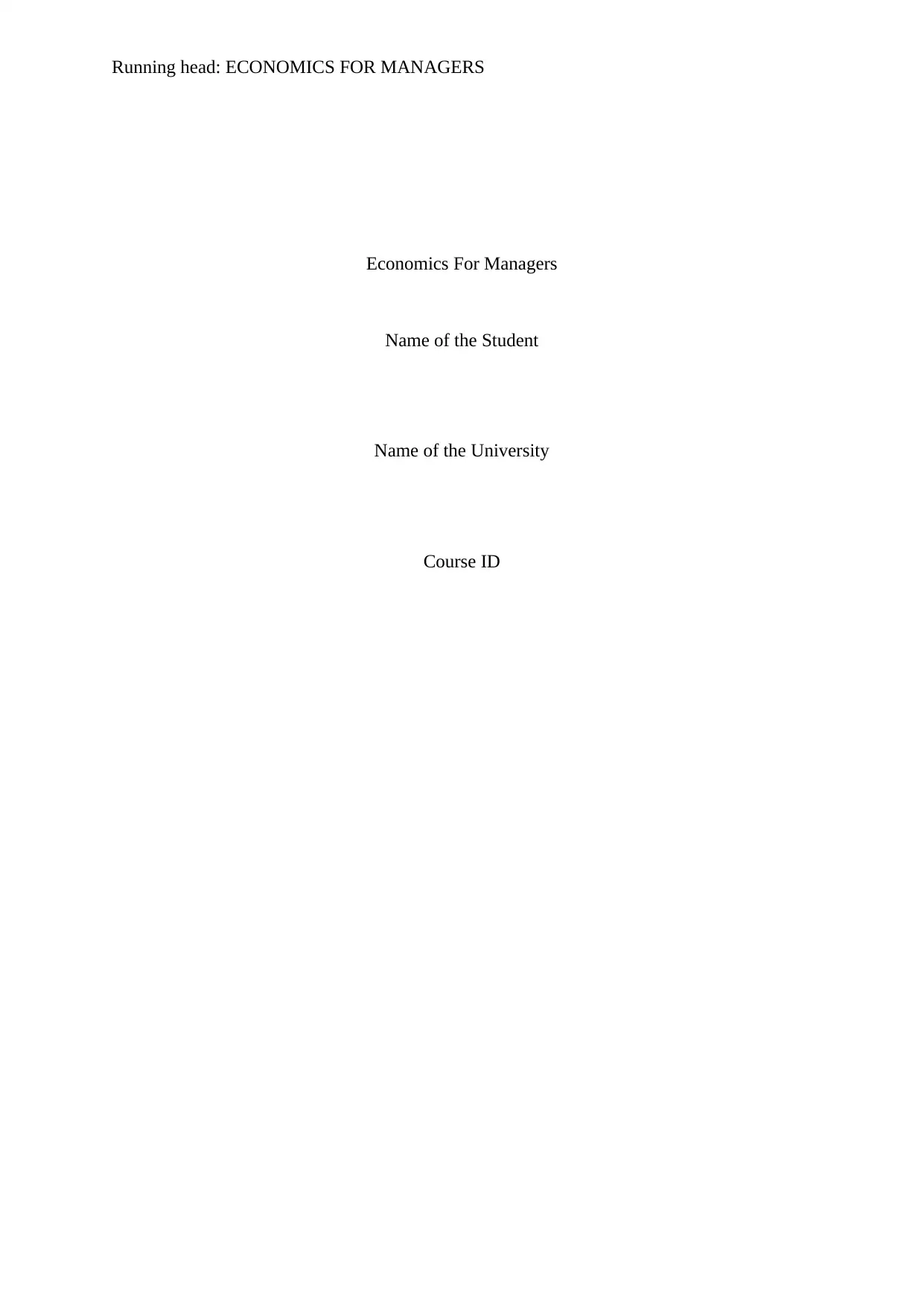
Running head: ECONOMICS FOR MANAGERS
Economics For Managers
Name of the Student
Name of the University
Course ID
Economics For Managers
Name of the Student
Name of the University
Course ID
Paraphrase This Document
Need a fresh take? Get an instant paraphrase of this document with our AI Paraphraser
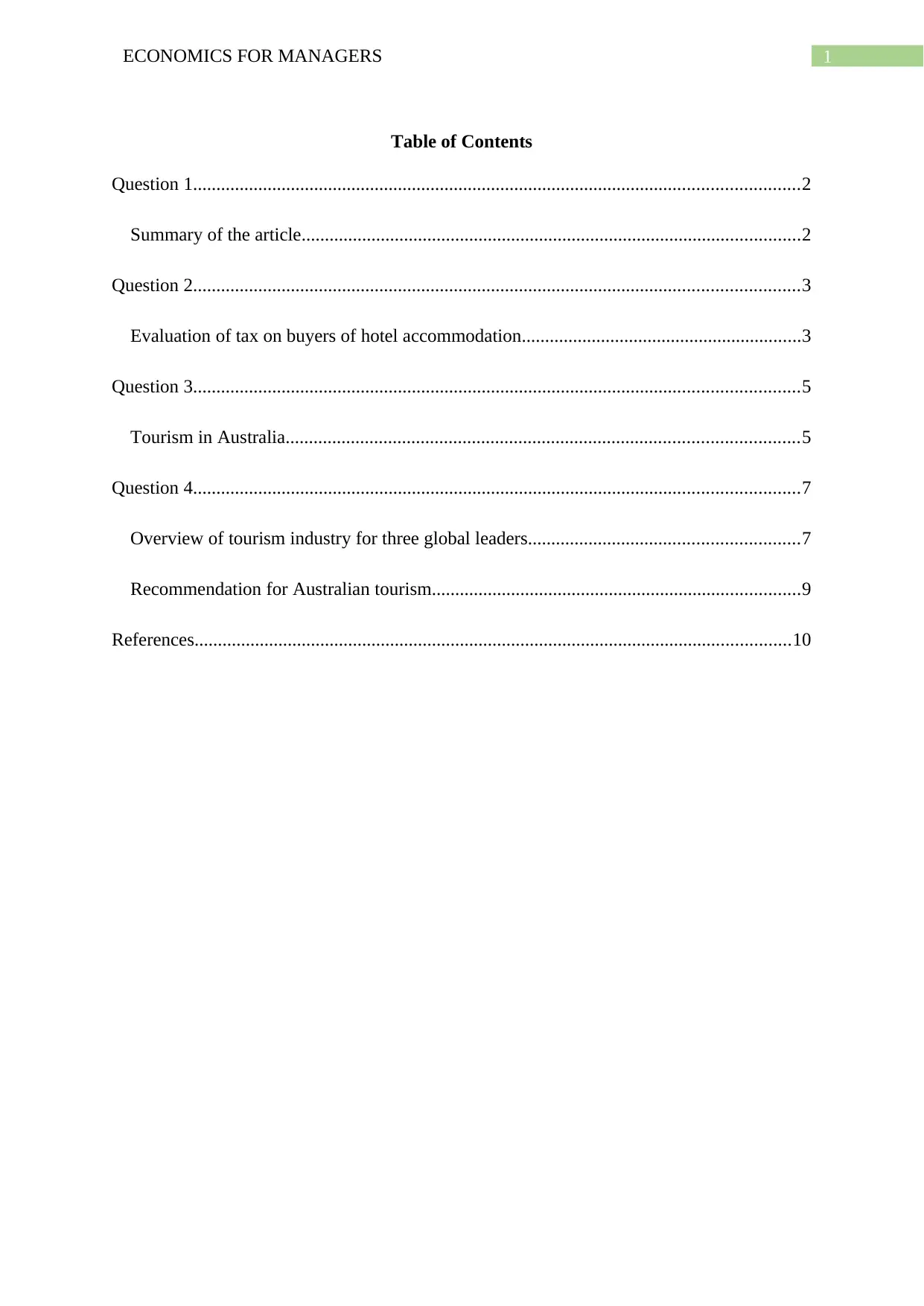
1ECONOMICS FOR MANAGERS
Table of Contents
Question 1..................................................................................................................................2
Summary of the article...........................................................................................................2
Question 2..................................................................................................................................3
Evaluation of tax on buyers of hotel accommodation............................................................3
Question 3..................................................................................................................................5
Tourism in Australia..............................................................................................................5
Question 4..................................................................................................................................7
Overview of tourism industry for three global leaders..........................................................7
Recommendation for Australian tourism...............................................................................9
References................................................................................................................................10
Table of Contents
Question 1..................................................................................................................................2
Summary of the article...........................................................................................................2
Question 2..................................................................................................................................3
Evaluation of tax on buyers of hotel accommodation............................................................3
Question 3..................................................................................................................................5
Tourism in Australia..............................................................................................................5
Question 4..................................................................................................................................7
Overview of tourism industry for three global leaders..........................................................7
Recommendation for Australian tourism...............................................................................9
References................................................................................................................................10
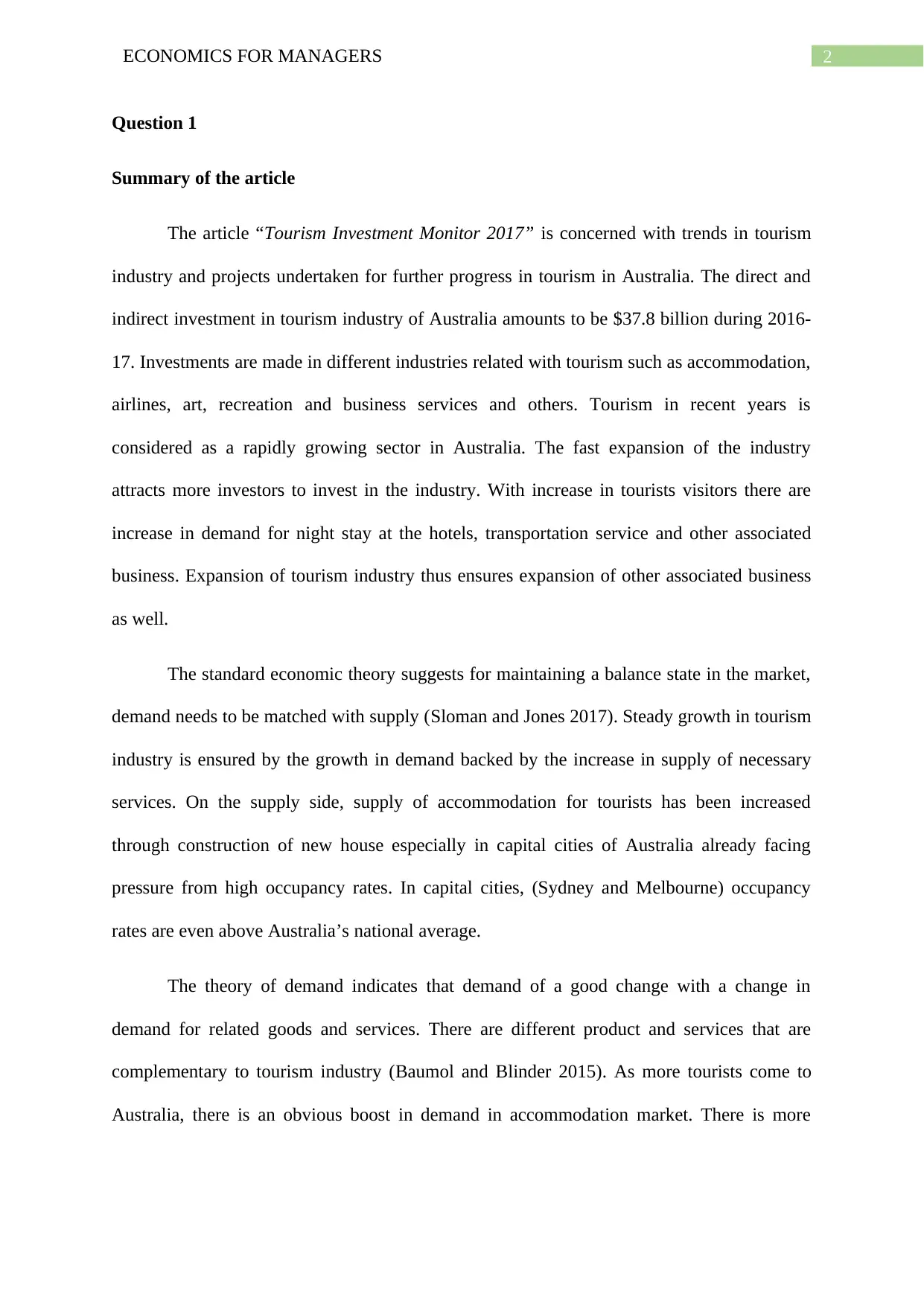
2ECONOMICS FOR MANAGERS
Question 1
Summary of the article
The article “Tourism Investment Monitor 2017” is concerned with trends in tourism
industry and projects undertaken for further progress in tourism in Australia. The direct and
indirect investment in tourism industry of Australia amounts to be $37.8 billion during 2016-
17. Investments are made in different industries related with tourism such as accommodation,
airlines, art, recreation and business services and others. Tourism in recent years is
considered as a rapidly growing sector in Australia. The fast expansion of the industry
attracts more investors to invest in the industry. With increase in tourists visitors there are
increase in demand for night stay at the hotels, transportation service and other associated
business. Expansion of tourism industry thus ensures expansion of other associated business
as well.
The standard economic theory suggests for maintaining a balance state in the market,
demand needs to be matched with supply (Sloman and Jones 2017). Steady growth in tourism
industry is ensured by the growth in demand backed by the increase in supply of necessary
services. On the supply side, supply of accommodation for tourists has been increased
through construction of new house especially in capital cities of Australia already facing
pressure from high occupancy rates. In capital cities, (Sydney and Melbourne) occupancy
rates are even above Australia’s national average.
The theory of demand indicates that demand of a good change with a change in
demand for related goods and services. There are different product and services that are
complementary to tourism industry (Baumol and Blinder 2015). As more tourists come to
Australia, there is an obvious boost in demand in accommodation market. There is more
Question 1
Summary of the article
The article “Tourism Investment Monitor 2017” is concerned with trends in tourism
industry and projects undertaken for further progress in tourism in Australia. The direct and
indirect investment in tourism industry of Australia amounts to be $37.8 billion during 2016-
17. Investments are made in different industries related with tourism such as accommodation,
airlines, art, recreation and business services and others. Tourism in recent years is
considered as a rapidly growing sector in Australia. The fast expansion of the industry
attracts more investors to invest in the industry. With increase in tourists visitors there are
increase in demand for night stay at the hotels, transportation service and other associated
business. Expansion of tourism industry thus ensures expansion of other associated business
as well.
The standard economic theory suggests for maintaining a balance state in the market,
demand needs to be matched with supply (Sloman and Jones 2017). Steady growth in tourism
industry is ensured by the growth in demand backed by the increase in supply of necessary
services. On the supply side, supply of accommodation for tourists has been increased
through construction of new house especially in capital cities of Australia already facing
pressure from high occupancy rates. In capital cities, (Sydney and Melbourne) occupancy
rates are even above Australia’s national average.
The theory of demand indicates that demand of a good change with a change in
demand for related goods and services. There are different product and services that are
complementary to tourism industry (Baumol and Blinder 2015). As more tourists come to
Australia, there is an obvious boost in demand in accommodation market. There is more
⊘ This is a preview!⊘
Do you want full access?
Subscribe today to unlock all pages.

Trusted by 1+ million students worldwide
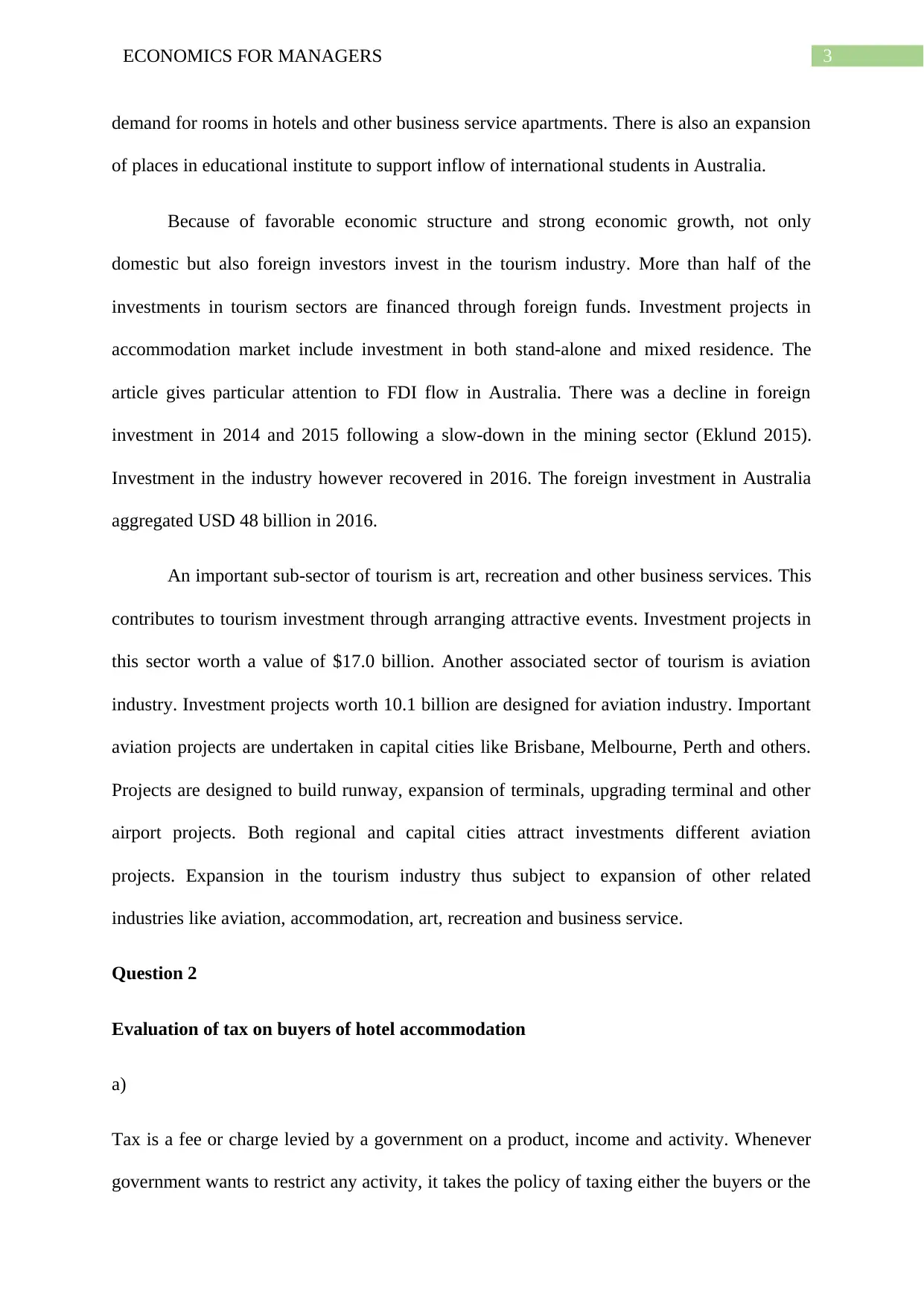
3ECONOMICS FOR MANAGERS
demand for rooms in hotels and other business service apartments. There is also an expansion
of places in educational institute to support inflow of international students in Australia.
Because of favorable economic structure and strong economic growth, not only
domestic but also foreign investors invest in the tourism industry. More than half of the
investments in tourism sectors are financed through foreign funds. Investment projects in
accommodation market include investment in both stand-alone and mixed residence. The
article gives particular attention to FDI flow in Australia. There was a decline in foreign
investment in 2014 and 2015 following a slow-down in the mining sector (Eklund 2015).
Investment in the industry however recovered in 2016. The foreign investment in Australia
aggregated USD 48 billion in 2016.
An important sub-sector of tourism is art, recreation and other business services. This
contributes to tourism investment through arranging attractive events. Investment projects in
this sector worth a value of $17.0 billion. Another associated sector of tourism is aviation
industry. Investment projects worth 10.1 billion are designed for aviation industry. Important
aviation projects are undertaken in capital cities like Brisbane, Melbourne, Perth and others.
Projects are designed to build runway, expansion of terminals, upgrading terminal and other
airport projects. Both regional and capital cities attract investments different aviation
projects. Expansion in the tourism industry thus subject to expansion of other related
industries like aviation, accommodation, art, recreation and business service.
Question 2
Evaluation of tax on buyers of hotel accommodation
a)
Tax is a fee or charge levied by a government on a product, income and activity. Whenever
government wants to restrict any activity, it takes the policy of taxing either the buyers or the
demand for rooms in hotels and other business service apartments. There is also an expansion
of places in educational institute to support inflow of international students in Australia.
Because of favorable economic structure and strong economic growth, not only
domestic but also foreign investors invest in the tourism industry. More than half of the
investments in tourism sectors are financed through foreign funds. Investment projects in
accommodation market include investment in both stand-alone and mixed residence. The
article gives particular attention to FDI flow in Australia. There was a decline in foreign
investment in 2014 and 2015 following a slow-down in the mining sector (Eklund 2015).
Investment in the industry however recovered in 2016. The foreign investment in Australia
aggregated USD 48 billion in 2016.
An important sub-sector of tourism is art, recreation and other business services. This
contributes to tourism investment through arranging attractive events. Investment projects in
this sector worth a value of $17.0 billion. Another associated sector of tourism is aviation
industry. Investment projects worth 10.1 billion are designed for aviation industry. Important
aviation projects are undertaken in capital cities like Brisbane, Melbourne, Perth and others.
Projects are designed to build runway, expansion of terminals, upgrading terminal and other
airport projects. Both regional and capital cities attract investments different aviation
projects. Expansion in the tourism industry thus subject to expansion of other related
industries like aviation, accommodation, art, recreation and business service.
Question 2
Evaluation of tax on buyers of hotel accommodation
a)
Tax is a fee or charge levied by a government on a product, income and activity. Whenever
government wants to restrict any activity, it takes the policy of taxing either the buyers or the
Paraphrase This Document
Need a fresh take? Get an instant paraphrase of this document with our AI Paraphraser
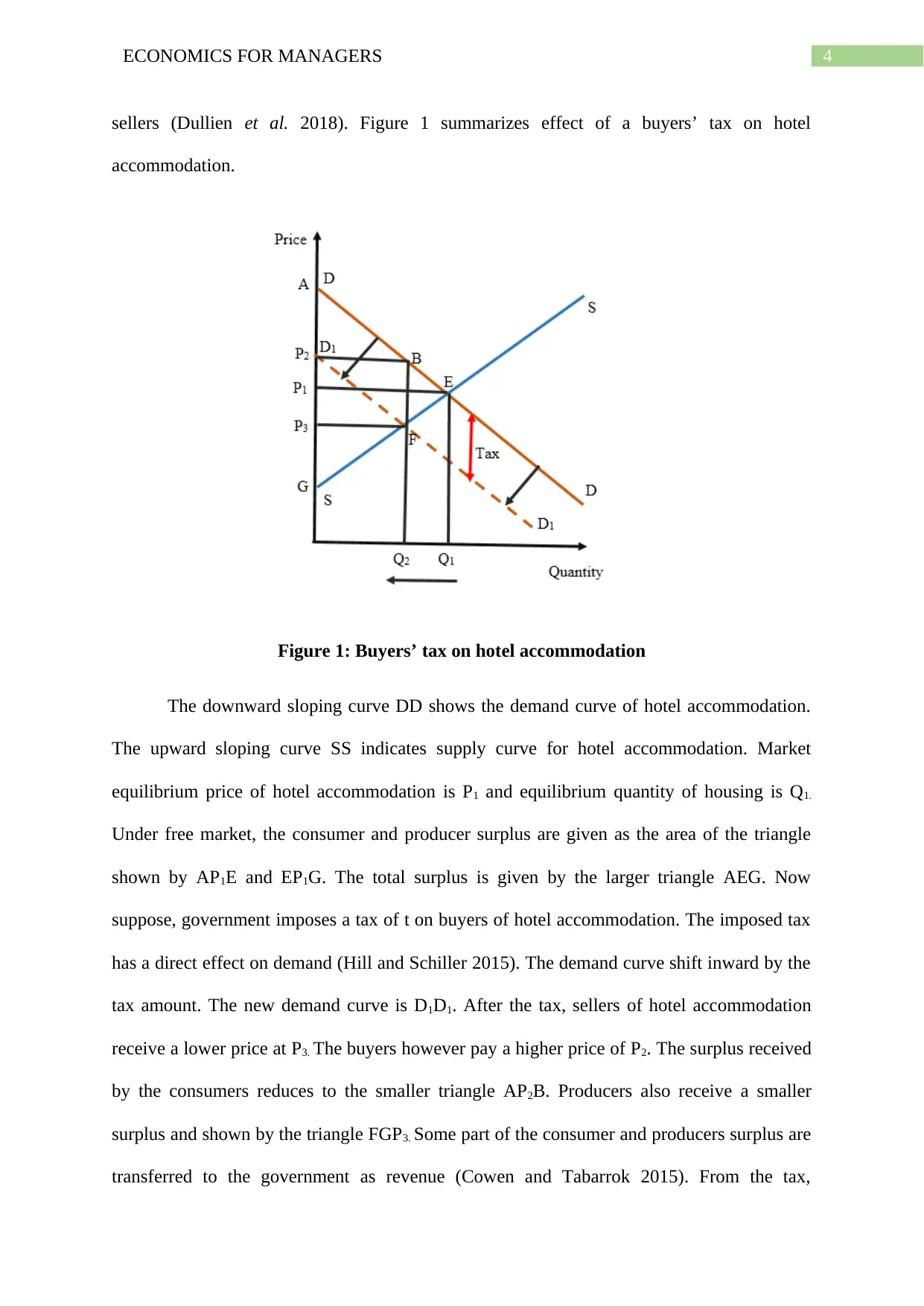
4ECONOMICS FOR MANAGERS
sellers (Dullien et al. 2018). Figure 1 summarizes effect of a buyers’ tax on hotel
accommodation.
Figure 1: Buyers’ tax on hotel accommodation
The downward sloping curve DD shows the demand curve of hotel accommodation.
The upward sloping curve SS indicates supply curve for hotel accommodation. Market
equilibrium price of hotel accommodation is P1 and equilibrium quantity of housing is Q1.
Under free market, the consumer and producer surplus are given as the area of the triangle
shown by AP1E and EP1G. The total surplus is given by the larger triangle AEG. Now
suppose, government imposes a tax of t on buyers of hotel accommodation. The imposed tax
has a direct effect on demand (Hill and Schiller 2015). The demand curve shift inward by the
tax amount. The new demand curve is D1D1. After the tax, sellers of hotel accommodation
receive a lower price at P3. The buyers however pay a higher price of P2. The surplus received
by the consumers reduces to the smaller triangle AP2B. Producers also receive a smaller
surplus and shown by the triangle FGP3. Some part of the consumer and producers surplus are
transferred to the government as revenue (Cowen and Tabarrok 2015). From the tax,
sellers (Dullien et al. 2018). Figure 1 summarizes effect of a buyers’ tax on hotel
accommodation.
Figure 1: Buyers’ tax on hotel accommodation
The downward sloping curve DD shows the demand curve of hotel accommodation.
The upward sloping curve SS indicates supply curve for hotel accommodation. Market
equilibrium price of hotel accommodation is P1 and equilibrium quantity of housing is Q1.
Under free market, the consumer and producer surplus are given as the area of the triangle
shown by AP1E and EP1G. The total surplus is given by the larger triangle AEG. Now
suppose, government imposes a tax of t on buyers of hotel accommodation. The imposed tax
has a direct effect on demand (Hill and Schiller 2015). The demand curve shift inward by the
tax amount. The new demand curve is D1D1. After the tax, sellers of hotel accommodation
receive a lower price at P3. The buyers however pay a higher price of P2. The surplus received
by the consumers reduces to the smaller triangle AP2B. Producers also receive a smaller
surplus and shown by the triangle FGP3. Some part of the consumer and producers surplus are
transferred to the government as revenue (Cowen and Tabarrok 2015). From the tax,
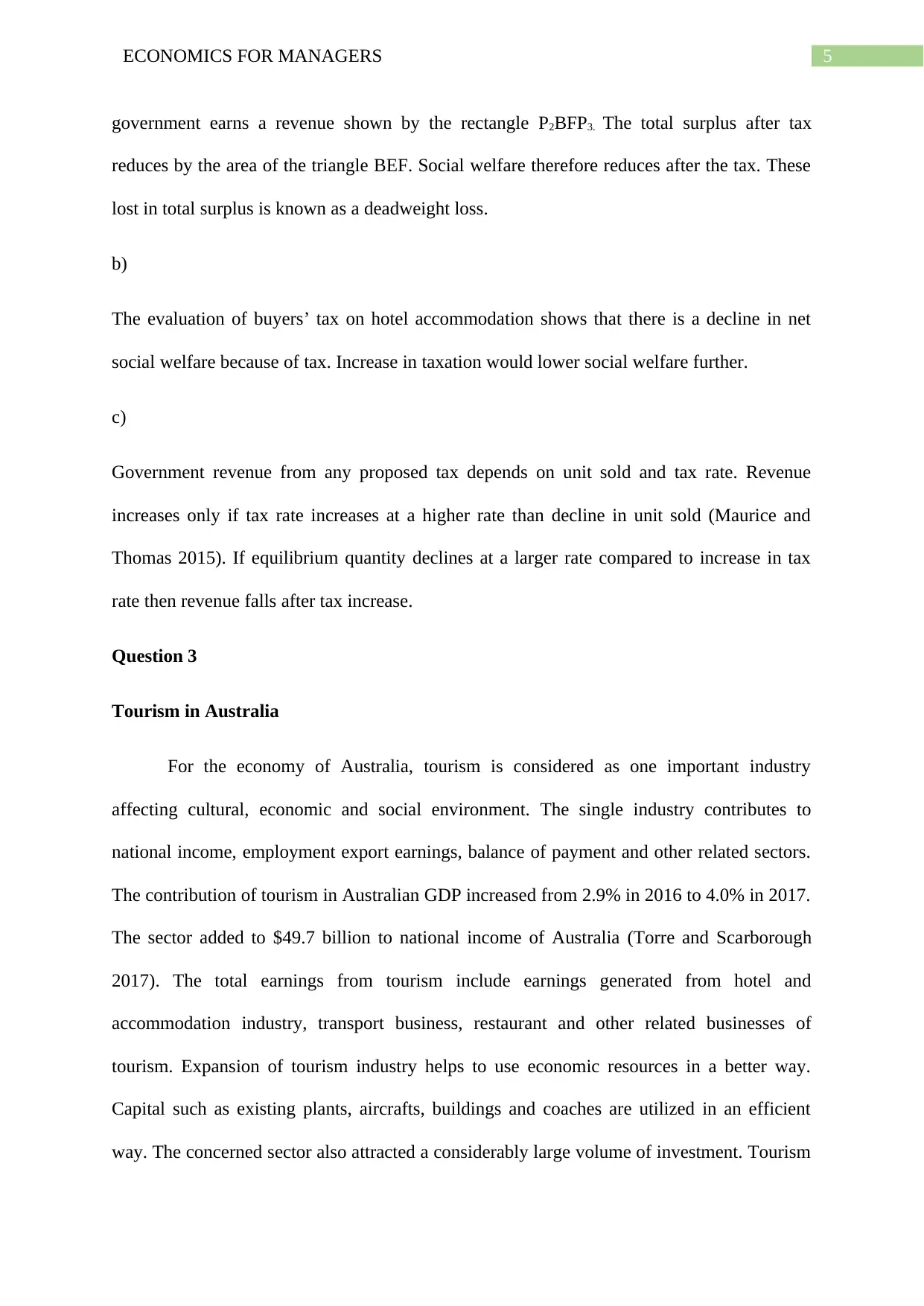
5ECONOMICS FOR MANAGERS
government earns a revenue shown by the rectangle P2BFP3. The total surplus after tax
reduces by the area of the triangle BEF. Social welfare therefore reduces after the tax. These
lost in total surplus is known as a deadweight loss.
b)
The evaluation of buyers’ tax on hotel accommodation shows that there is a decline in net
social welfare because of tax. Increase in taxation would lower social welfare further.
c)
Government revenue from any proposed tax depends on unit sold and tax rate. Revenue
increases only if tax rate increases at a higher rate than decline in unit sold (Maurice and
Thomas 2015). If equilibrium quantity declines at a larger rate compared to increase in tax
rate then revenue falls after tax increase.
Question 3
Tourism in Australia
For the economy of Australia, tourism is considered as one important industry
affecting cultural, economic and social environment. The single industry contributes to
national income, employment export earnings, balance of payment and other related sectors.
The contribution of tourism in Australian GDP increased from 2.9% in 2016 to 4.0% in 2017.
The sector added to $49.7 billion to national income of Australia (Torre and Scarborough
2017). The total earnings from tourism include earnings generated from hotel and
accommodation industry, transport business, restaurant and other related businesses of
tourism. Expansion of tourism industry helps to use economic resources in a better way.
Capital such as existing plants, aircrafts, buildings and coaches are utilized in an efficient
way. The concerned sector also attracted a considerably large volume of investment. Tourism
government earns a revenue shown by the rectangle P2BFP3. The total surplus after tax
reduces by the area of the triangle BEF. Social welfare therefore reduces after the tax. These
lost in total surplus is known as a deadweight loss.
b)
The evaluation of buyers’ tax on hotel accommodation shows that there is a decline in net
social welfare because of tax. Increase in taxation would lower social welfare further.
c)
Government revenue from any proposed tax depends on unit sold and tax rate. Revenue
increases only if tax rate increases at a higher rate than decline in unit sold (Maurice and
Thomas 2015). If equilibrium quantity declines at a larger rate compared to increase in tax
rate then revenue falls after tax increase.
Question 3
Tourism in Australia
For the economy of Australia, tourism is considered as one important industry
affecting cultural, economic and social environment. The single industry contributes to
national income, employment export earnings, balance of payment and other related sectors.
The contribution of tourism in Australian GDP increased from 2.9% in 2016 to 4.0% in 2017.
The sector added to $49.7 billion to national income of Australia (Torre and Scarborough
2017). The total earnings from tourism include earnings generated from hotel and
accommodation industry, transport business, restaurant and other related businesses of
tourism. Expansion of tourism industry helps to use economic resources in a better way.
Capital such as existing plants, aircrafts, buildings and coaches are utilized in an efficient
way. The concerned sector also attracted a considerably large volume of investment. Tourism
⊘ This is a preview!⊘
Do you want full access?
Subscribe today to unlock all pages.

Trusted by 1+ million students worldwide
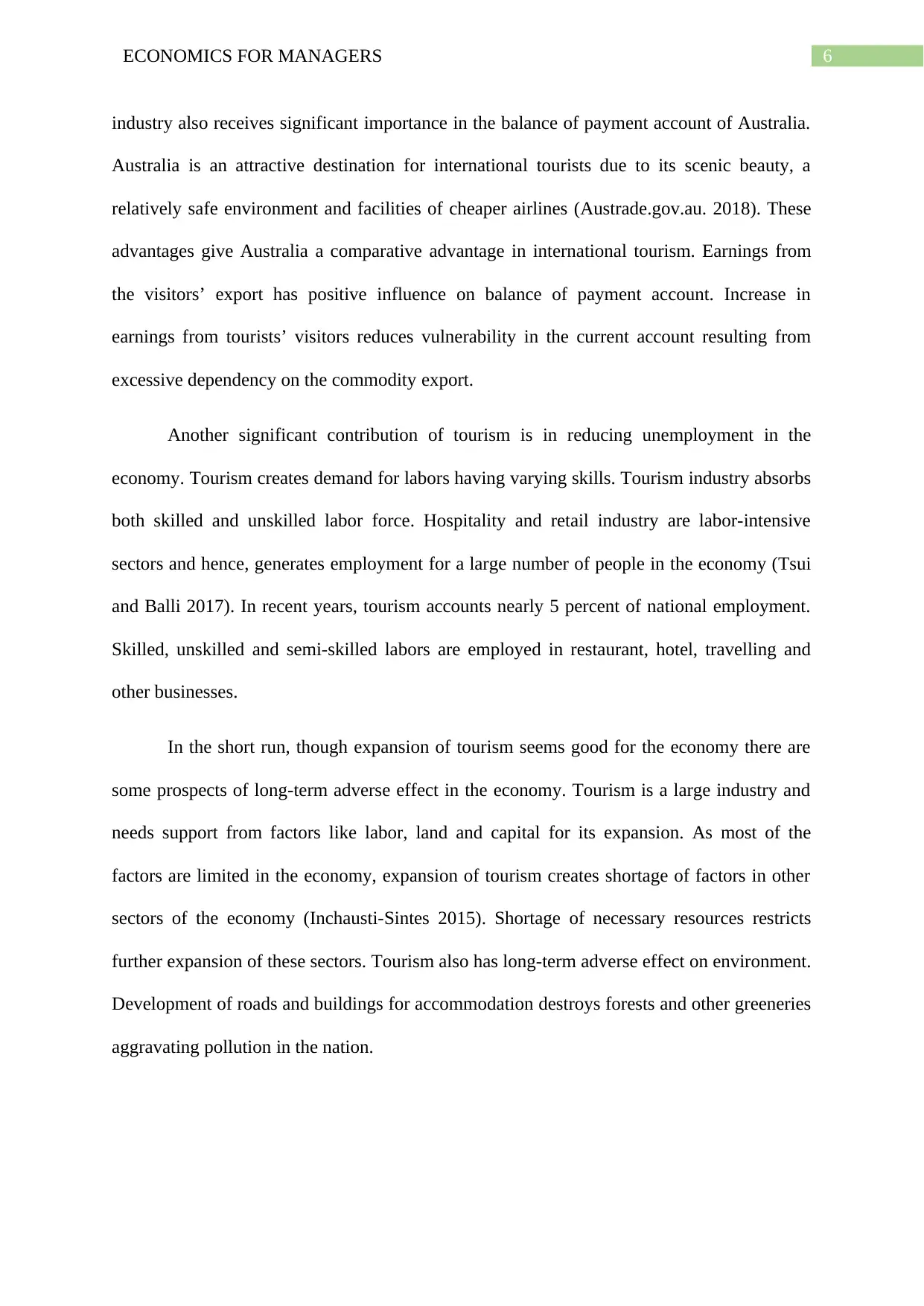
6ECONOMICS FOR MANAGERS
industry also receives significant importance in the balance of payment account of Australia.
Australia is an attractive destination for international tourists due to its scenic beauty, a
relatively safe environment and facilities of cheaper airlines (Austrade.gov.au. 2018). These
advantages give Australia a comparative advantage in international tourism. Earnings from
the visitors’ export has positive influence on balance of payment account. Increase in
earnings from tourists’ visitors reduces vulnerability in the current account resulting from
excessive dependency on the commodity export.
Another significant contribution of tourism is in reducing unemployment in the
economy. Tourism creates demand for labors having varying skills. Tourism industry absorbs
both skilled and unskilled labor force. Hospitality and retail industry are labor-intensive
sectors and hence, generates employment for a large number of people in the economy (Tsui
and Balli 2017). In recent years, tourism accounts nearly 5 percent of national employment.
Skilled, unskilled and semi-skilled labors are employed in restaurant, hotel, travelling and
other businesses.
In the short run, though expansion of tourism seems good for the economy there are
some prospects of long-term adverse effect in the economy. Tourism is a large industry and
needs support from factors like labor, land and capital for its expansion. As most of the
factors are limited in the economy, expansion of tourism creates shortage of factors in other
sectors of the economy (Inchausti-Sintes 2015). Shortage of necessary resources restricts
further expansion of these sectors. Tourism also has long-term adverse effect on environment.
Development of roads and buildings for accommodation destroys forests and other greeneries
aggravating pollution in the nation.
industry also receives significant importance in the balance of payment account of Australia.
Australia is an attractive destination for international tourists due to its scenic beauty, a
relatively safe environment and facilities of cheaper airlines (Austrade.gov.au. 2018). These
advantages give Australia a comparative advantage in international tourism. Earnings from
the visitors’ export has positive influence on balance of payment account. Increase in
earnings from tourists’ visitors reduces vulnerability in the current account resulting from
excessive dependency on the commodity export.
Another significant contribution of tourism is in reducing unemployment in the
economy. Tourism creates demand for labors having varying skills. Tourism industry absorbs
both skilled and unskilled labor force. Hospitality and retail industry are labor-intensive
sectors and hence, generates employment for a large number of people in the economy (Tsui
and Balli 2017). In recent years, tourism accounts nearly 5 percent of national employment.
Skilled, unskilled and semi-skilled labors are employed in restaurant, hotel, travelling and
other businesses.
In the short run, though expansion of tourism seems good for the economy there are
some prospects of long-term adverse effect in the economy. Tourism is a large industry and
needs support from factors like labor, land and capital for its expansion. As most of the
factors are limited in the economy, expansion of tourism creates shortage of factors in other
sectors of the economy (Inchausti-Sintes 2015). Shortage of necessary resources restricts
further expansion of these sectors. Tourism also has long-term adverse effect on environment.
Development of roads and buildings for accommodation destroys forests and other greeneries
aggravating pollution in the nation.
Paraphrase This Document
Need a fresh take? Get an instant paraphrase of this document with our AI Paraphraser
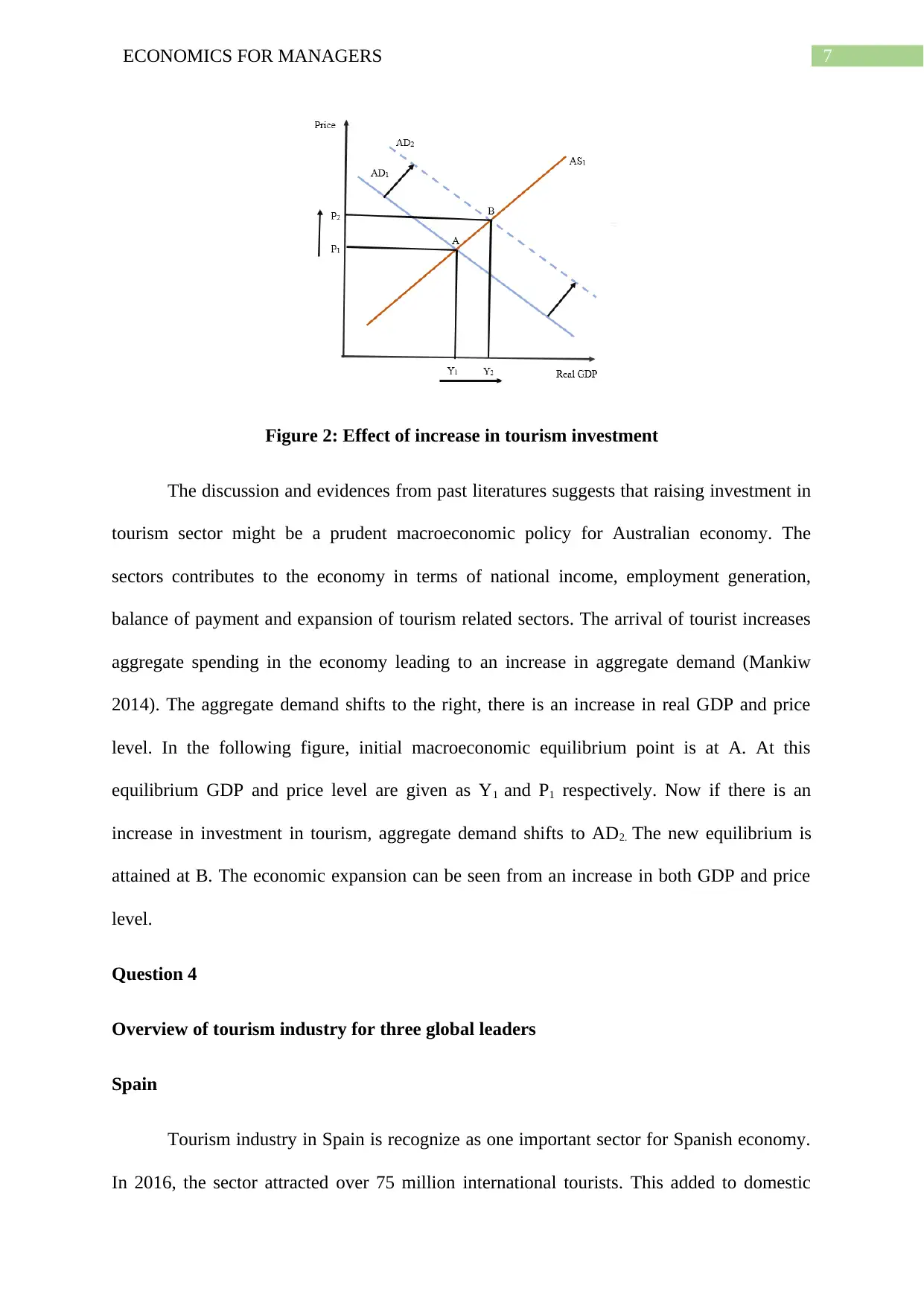
7ECONOMICS FOR MANAGERS
Figure 2: Effect of increase in tourism investment
The discussion and evidences from past literatures suggests that raising investment in
tourism sector might be a prudent macroeconomic policy for Australian economy. The
sectors contributes to the economy in terms of national income, employment generation,
balance of payment and expansion of tourism related sectors. The arrival of tourist increases
aggregate spending in the economy leading to an increase in aggregate demand (Mankiw
2014). The aggregate demand shifts to the right, there is an increase in real GDP and price
level. In the following figure, initial macroeconomic equilibrium point is at A. At this
equilibrium GDP and price level are given as Y1 and P1 respectively. Now if there is an
increase in investment in tourism, aggregate demand shifts to AD2. The new equilibrium is
attained at B. The economic expansion can be seen from an increase in both GDP and price
level.
Question 4
Overview of tourism industry for three global leaders
Spain
Tourism industry in Spain is recognize as one important sector for Spanish economy.
In 2016, the sector attracted over 75 million international tourists. This added to domestic
Figure 2: Effect of increase in tourism investment
The discussion and evidences from past literatures suggests that raising investment in
tourism sector might be a prudent macroeconomic policy for Australian economy. The
sectors contributes to the economy in terms of national income, employment generation,
balance of payment and expansion of tourism related sectors. The arrival of tourist increases
aggregate spending in the economy leading to an increase in aggregate demand (Mankiw
2014). The aggregate demand shifts to the right, there is an increase in real GDP and price
level. In the following figure, initial macroeconomic equilibrium point is at A. At this
equilibrium GDP and price level are given as Y1 and P1 respectively. Now if there is an
increase in investment in tourism, aggregate demand shifts to AD2. The new equilibrium is
attained at B. The economic expansion can be seen from an increase in both GDP and price
level.
Question 4
Overview of tourism industry for three global leaders
Spain
Tourism industry in Spain is recognize as one important sector for Spanish economy.
In 2016, the sector attracted over 75 million international tourists. This added to domestic
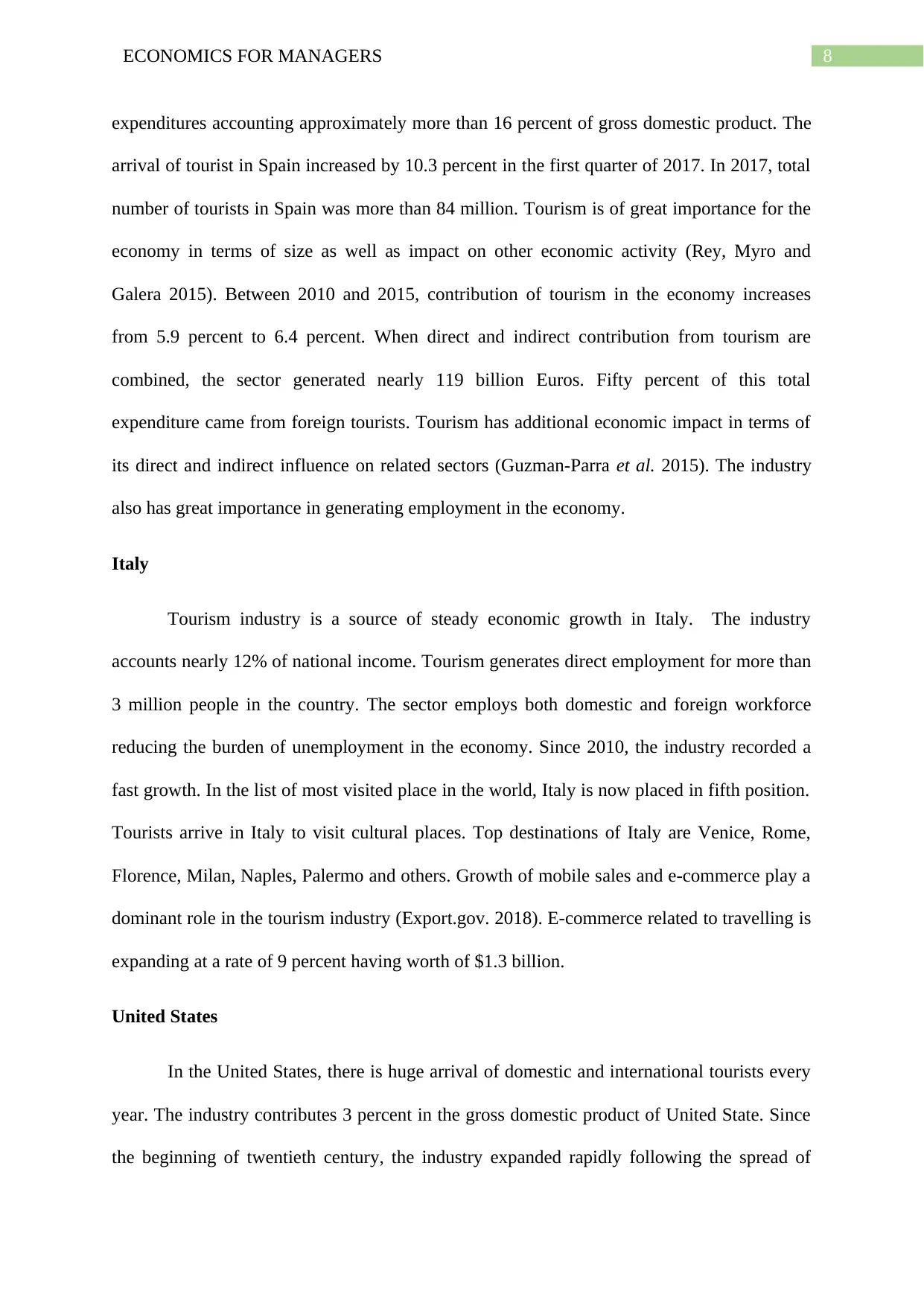
8ECONOMICS FOR MANAGERS
expenditures accounting approximately more than 16 percent of gross domestic product. The
arrival of tourist in Spain increased by 10.3 percent in the first quarter of 2017. In 2017, total
number of tourists in Spain was more than 84 million. Tourism is of great importance for the
economy in terms of size as well as impact on other economic activity (Rey, Myro and
Galera 2015). Between 2010 and 2015, contribution of tourism in the economy increases
from 5.9 percent to 6.4 percent. When direct and indirect contribution from tourism are
combined, the sector generated nearly 119 billion Euros. Fifty percent of this total
expenditure came from foreign tourists. Tourism has additional economic impact in terms of
its direct and indirect influence on related sectors (Guzman-Parra et al. 2015). The industry
also has great importance in generating employment in the economy.
Italy
Tourism industry is a source of steady economic growth in Italy. The industry
accounts nearly 12% of national income. Tourism generates direct employment for more than
3 million people in the country. The sector employs both domestic and foreign workforce
reducing the burden of unemployment in the economy. Since 2010, the industry recorded a
fast growth. In the list of most visited place in the world, Italy is now placed in fifth position.
Tourists arrive in Italy to visit cultural places. Top destinations of Italy are Venice, Rome,
Florence, Milan, Naples, Palermo and others. Growth of mobile sales and e-commerce play a
dominant role in the tourism industry (Export.gov. 2018). E-commerce related to travelling is
expanding at a rate of 9 percent having worth of $1.3 billion.
United States
In the United States, there is huge arrival of domestic and international tourists every
year. The industry contributes 3 percent in the gross domestic product of United State. Since
the beginning of twentieth century, the industry expanded rapidly following the spread of
expenditures accounting approximately more than 16 percent of gross domestic product. The
arrival of tourist in Spain increased by 10.3 percent in the first quarter of 2017. In 2017, total
number of tourists in Spain was more than 84 million. Tourism is of great importance for the
economy in terms of size as well as impact on other economic activity (Rey, Myro and
Galera 2015). Between 2010 and 2015, contribution of tourism in the economy increases
from 5.9 percent to 6.4 percent. When direct and indirect contribution from tourism are
combined, the sector generated nearly 119 billion Euros. Fifty percent of this total
expenditure came from foreign tourists. Tourism has additional economic impact in terms of
its direct and indirect influence on related sectors (Guzman-Parra et al. 2015). The industry
also has great importance in generating employment in the economy.
Italy
Tourism industry is a source of steady economic growth in Italy. The industry
accounts nearly 12% of national income. Tourism generates direct employment for more than
3 million people in the country. The sector employs both domestic and foreign workforce
reducing the burden of unemployment in the economy. Since 2010, the industry recorded a
fast growth. In the list of most visited place in the world, Italy is now placed in fifth position.
Tourists arrive in Italy to visit cultural places. Top destinations of Italy are Venice, Rome,
Florence, Milan, Naples, Palermo and others. Growth of mobile sales and e-commerce play a
dominant role in the tourism industry (Export.gov. 2018). E-commerce related to travelling is
expanding at a rate of 9 percent having worth of $1.3 billion.
United States
In the United States, there is huge arrival of domestic and international tourists every
year. The industry contributes 3 percent in the gross domestic product of United State. Since
the beginning of twentieth century, the industry expanded rapidly following the spread of
⊘ This is a preview!⊘
Do you want full access?
Subscribe today to unlock all pages.

Trusted by 1+ million students worldwide
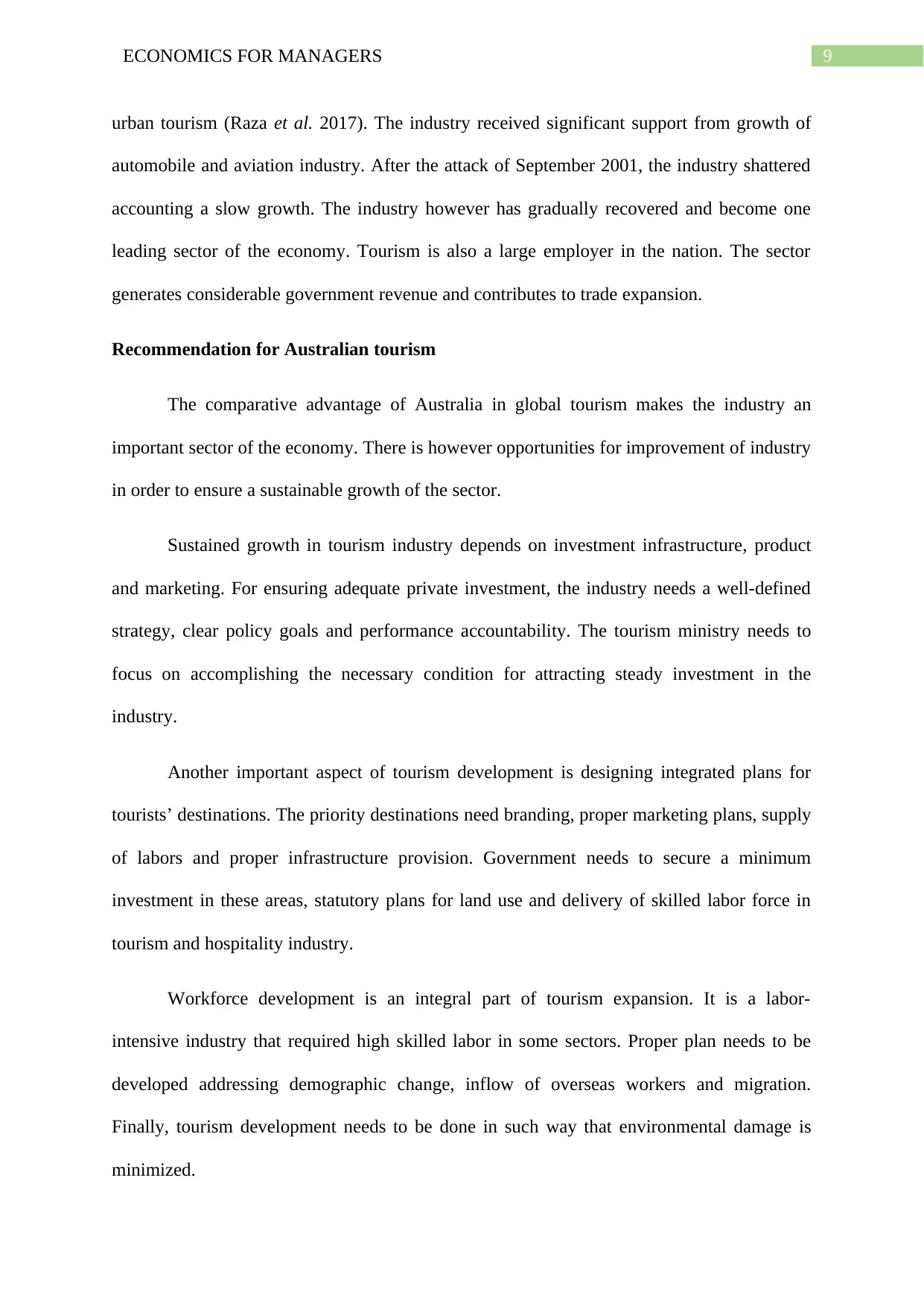
9ECONOMICS FOR MANAGERS
urban tourism (Raza et al. 2017). The industry received significant support from growth of
automobile and aviation industry. After the attack of September 2001, the industry shattered
accounting a slow growth. The industry however has gradually recovered and become one
leading sector of the economy. Tourism is also a large employer in the nation. The sector
generates considerable government revenue and contributes to trade expansion.
Recommendation for Australian tourism
The comparative advantage of Australia in global tourism makes the industry an
important sector of the economy. There is however opportunities for improvement of industry
in order to ensure a sustainable growth of the sector.
Sustained growth in tourism industry depends on investment infrastructure, product
and marketing. For ensuring adequate private investment, the industry needs a well-defined
strategy, clear policy goals and performance accountability. The tourism ministry needs to
focus on accomplishing the necessary condition for attracting steady investment in the
industry.
Another important aspect of tourism development is designing integrated plans for
tourists’ destinations. The priority destinations need branding, proper marketing plans, supply
of labors and proper infrastructure provision. Government needs to secure a minimum
investment in these areas, statutory plans for land use and delivery of skilled labor force in
tourism and hospitality industry.
Workforce development is an integral part of tourism expansion. It is a labor-
intensive industry that required high skilled labor in some sectors. Proper plan needs to be
developed addressing demographic change, inflow of overseas workers and migration.
Finally, tourism development needs to be done in such way that environmental damage is
minimized.
urban tourism (Raza et al. 2017). The industry received significant support from growth of
automobile and aviation industry. After the attack of September 2001, the industry shattered
accounting a slow growth. The industry however has gradually recovered and become one
leading sector of the economy. Tourism is also a large employer in the nation. The sector
generates considerable government revenue and contributes to trade expansion.
Recommendation for Australian tourism
The comparative advantage of Australia in global tourism makes the industry an
important sector of the economy. There is however opportunities for improvement of industry
in order to ensure a sustainable growth of the sector.
Sustained growth in tourism industry depends on investment infrastructure, product
and marketing. For ensuring adequate private investment, the industry needs a well-defined
strategy, clear policy goals and performance accountability. The tourism ministry needs to
focus on accomplishing the necessary condition for attracting steady investment in the
industry.
Another important aspect of tourism development is designing integrated plans for
tourists’ destinations. The priority destinations need branding, proper marketing plans, supply
of labors and proper infrastructure provision. Government needs to secure a minimum
investment in these areas, statutory plans for land use and delivery of skilled labor force in
tourism and hospitality industry.
Workforce development is an integral part of tourism expansion. It is a labor-
intensive industry that required high skilled labor in some sectors. Proper plan needs to be
developed addressing demographic change, inflow of overseas workers and migration.
Finally, tourism development needs to be done in such way that environmental damage is
minimized.
Paraphrase This Document
Need a fresh take? Get an instant paraphrase of this document with our AI Paraphraser

10ECONOMICS FOR MANAGERS
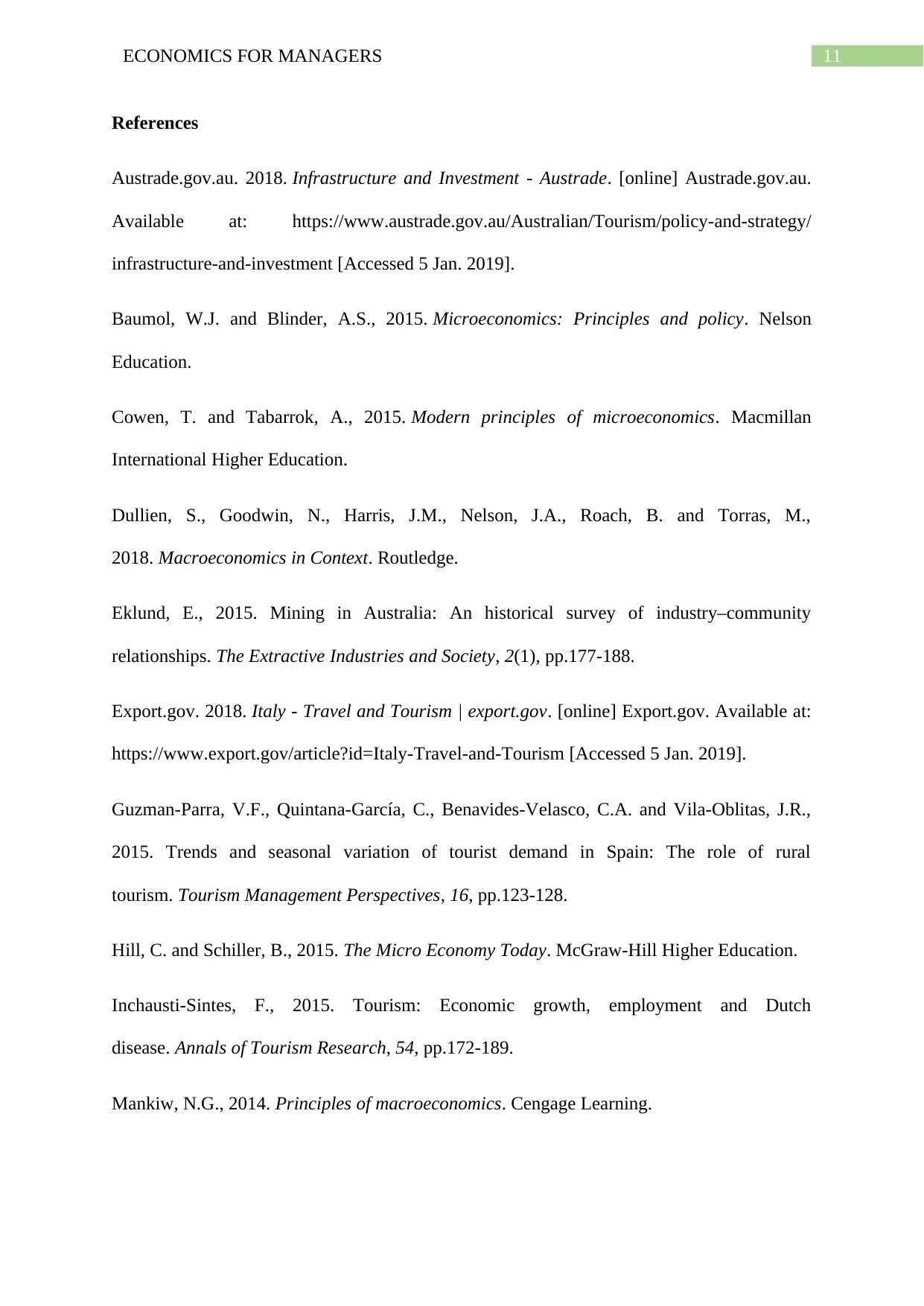
11ECONOMICS FOR MANAGERS
References
Austrade.gov.au. 2018. Infrastructure and Investment - Austrade. [online] Austrade.gov.au.
Available at: https://www.austrade.gov.au/Australian/Tourism/policy-and-strategy/
infrastructure-and-investment [Accessed 5 Jan. 2019].
Baumol, W.J. and Blinder, A.S., 2015. Microeconomics: Principles and policy. Nelson
Education.
Cowen, T. and Tabarrok, A., 2015. Modern principles of microeconomics. Macmillan
International Higher Education.
Dullien, S., Goodwin, N., Harris, J.M., Nelson, J.A., Roach, B. and Torras, M.,
2018. Macroeconomics in Context. Routledge.
Eklund, E., 2015. Mining in Australia: An historical survey of industry–community
relationships. The Extractive Industries and Society, 2(1), pp.177-188.
Export.gov. 2018. Italy - Travel and Tourism | export.gov. [online] Export.gov. Available at:
https://www.export.gov/article?id=Italy-Travel-and-Tourism [Accessed 5 Jan. 2019].
Guzman-Parra, V.F., Quintana-García, C., Benavides-Velasco, C.A. and Vila-Oblitas, J.R.,
2015. Trends and seasonal variation of tourist demand in Spain: The role of rural
tourism. Tourism Management Perspectives, 16, pp.123-128.
Hill, C. and Schiller, B., 2015. The Micro Economy Today. McGraw-Hill Higher Education.
Inchausti-Sintes, F., 2015. Tourism: Economic growth, employment and Dutch
disease. Annals of Tourism Research, 54, pp.172-189.
Mankiw, N.G., 2014. Principles of macroeconomics. Cengage Learning.
References
Austrade.gov.au. 2018. Infrastructure and Investment - Austrade. [online] Austrade.gov.au.
Available at: https://www.austrade.gov.au/Australian/Tourism/policy-and-strategy/
infrastructure-and-investment [Accessed 5 Jan. 2019].
Baumol, W.J. and Blinder, A.S., 2015. Microeconomics: Principles and policy. Nelson
Education.
Cowen, T. and Tabarrok, A., 2015. Modern principles of microeconomics. Macmillan
International Higher Education.
Dullien, S., Goodwin, N., Harris, J.M., Nelson, J.A., Roach, B. and Torras, M.,
2018. Macroeconomics in Context. Routledge.
Eklund, E., 2015. Mining in Australia: An historical survey of industry–community
relationships. The Extractive Industries and Society, 2(1), pp.177-188.
Export.gov. 2018. Italy - Travel and Tourism | export.gov. [online] Export.gov. Available at:
https://www.export.gov/article?id=Italy-Travel-and-Tourism [Accessed 5 Jan. 2019].
Guzman-Parra, V.F., Quintana-García, C., Benavides-Velasco, C.A. and Vila-Oblitas, J.R.,
2015. Trends and seasonal variation of tourist demand in Spain: The role of rural
tourism. Tourism Management Perspectives, 16, pp.123-128.
Hill, C. and Schiller, B., 2015. The Micro Economy Today. McGraw-Hill Higher Education.
Inchausti-Sintes, F., 2015. Tourism: Economic growth, employment and Dutch
disease. Annals of Tourism Research, 54, pp.172-189.
Mankiw, N.G., 2014. Principles of macroeconomics. Cengage Learning.
⊘ This is a preview!⊘
Do you want full access?
Subscribe today to unlock all pages.

Trusted by 1+ million students worldwide
1 out of 13
Related Documents
Your All-in-One AI-Powered Toolkit for Academic Success.
+13062052269
info@desklib.com
Available 24*7 on WhatsApp / Email
![[object Object]](/_next/static/media/star-bottom.7253800d.svg)
Unlock your academic potential
Copyright © 2020–2025 A2Z Services. All Rights Reserved. Developed and managed by ZUCOL.





